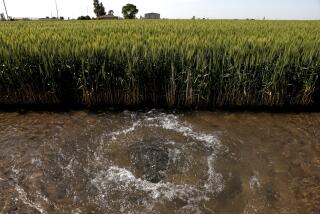White House Unveils Plan to Further Clean U.S. Waters : Environment: Proposals would rewrite and expand landmark 1972 federal act. Cutting flow of remaining toxics is termed ‘the hard part.’
- Share via
WASHINGTON — The Clinton Administration, grappling with what it called “the hard part” of water pollution control, on Tuesday unveiled a series of initiatives designed to improve the quality of the nation’s waterways.
In its broadest terms, the plan would streamline regulations, increase federal funds available to towns and cities and reduce the use of some toxic pollutants, such as chlorine, by American industry.
The package of proposals, which must be weighed by what appears to be a largely receptive Congress, would extend the life--and the reach--of the 1972 Clean Water Act, a landmark piece of environmental legislation that has dramatically cut the flow of industrial waste and toxins into American waters. Carol Browner, administrator of the Environmental Protection Agency, called that “the easy part.”
But with 38% of the country’s lakes, rivers and estuaries still too polluted for swimming or drinking, the Administration has designed a plan to attack still-unregulated sources of pollution. Those include agricultural runoff and municipal waste-water facilities that spill raw sewage into lakes and rivers when rain or melting snow cause them to overflow.
The plan would cost Americans roughly $70 billion a year to implement, an increase of roughly $6 billion over current spending by towns, cities and businesses on water pollution control. But Administration officials insisted that Americans will save if the package is adopted by Congress: Browner said that the changes would cost Americans $30 billion less to implement than would the law in its current form.
At stake in the debate is the health of rivers, lakes, estuaries and wetlands throughout the nation. Roughly 1,300 bodies of water have become so polluted that state authorities have had to limit public consumption of fish and shellfish that live in them.
While 20 years of controls have stemmed the flow of toxic chemicals into the water by major industrial enterprises, farmers and smaller industries continue to pour 740 million pounds of toxic chemicals into waterways and municipal sewers each year.
Such pollution causes as many as 3.2 million cases of intestinal disease yearly and is widely believed to contribute to cancer, nervous disorders and birth defects, officials said.
Citing the potential for these more serious effects, the Administration asked Congress on Tuesday to approve a federal study that would recommend whether and how to substitute, reduce or prohibit the use of chlorine in the United States.
Chlorine and related compounds, which are used at lower levels to clean water, are thought to lead to the creation of dioxin, which has been linked to birth defects and cancer.
Environmental groups and several key lawmakers hailed the Administration’s proposal. But environmental groups expressed concern that the government’s willingness to give states new latitude in enforcing anti-pollution measures might allow some polluters to escape censure.
Rep. Gerry E. Studds (D-Mass.), chairman of a House committee that will help draft a new Clean Water Act, also warned that existing federal funds will not be enough to pay for communities to improve their water facilities.
Studds gave the Administration what he called a “friendly nudge” to adopt a proposal under which the federal government would raise $4 billion in new environmental taxes on commercial and industrial water users and the makers of pesticides, fertilizers and animal feed.
To reduce the diffuse sources of pollution such as agricultural runoff and storm overflow, the new legislative proposal would give states almost eight years to implement pollution controls to reduce farm runoff. The proposal also would make federal money available to states to fund activities designed to reduce pollutants from fields and storm drains.
While such aid has been provided in the past, the federal government has placed strict limits on the types of projects that can be undertaken with the money. But under the Clinton plan, states also would be given new latitude in parceling out federal funds to communities.
For the first time, for instance, the funds could be used to create wetlands, to promote water conservation or to experiment with agricultural programs that use fewer toxic pesticides.
In an effort to step up enforcement of anti-pollution laws, the Administration also will ask Congress to make federal facilities such as Energy and Defense Department installations subject to all Clean Water Act provisions and to allow citizens to sue the government for violations.
Under another proposal, citizens would be permitted, within five years, to sue water polluters for past violations even if the polluter had come into compliance. A recent Supreme Court decision had severely curtailed citizens’ right to sue under such circumstances.
More to Read
Sign up for Essential California
The most important California stories and recommendations in your inbox every morning.
You may occasionally receive promotional content from the Los Angeles Times.











